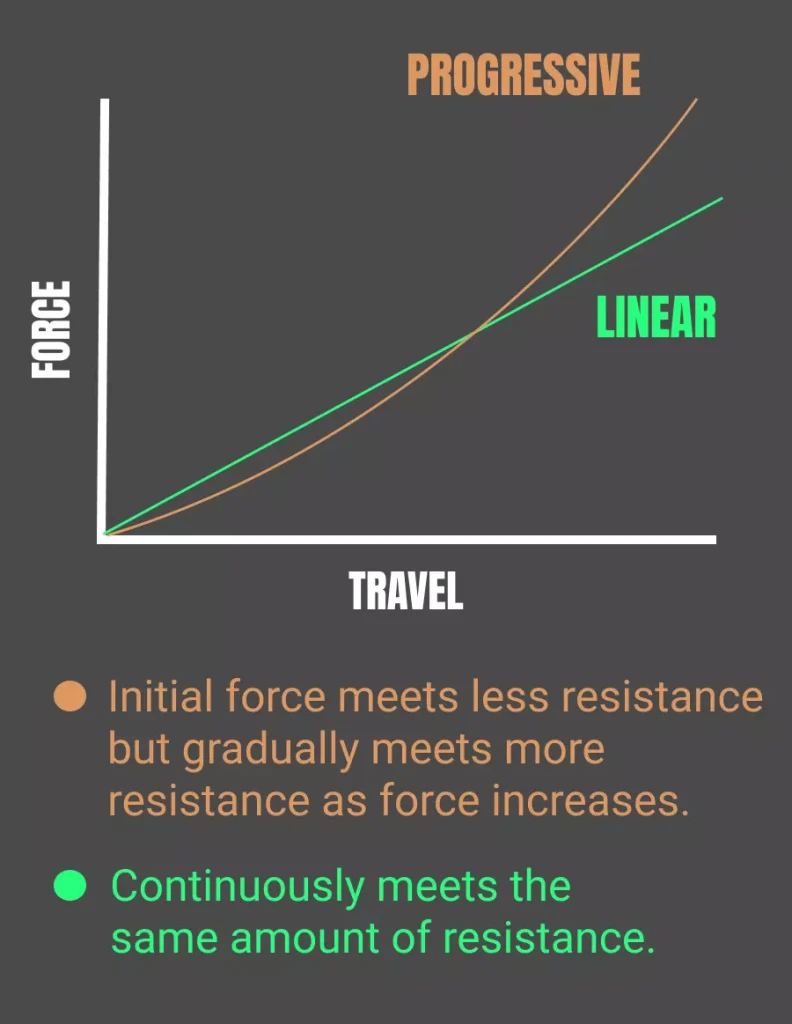
Suspension tuning MTB for Your Mountain Bike: Linear vs. Progressive Suspension
Suspension tuning MTB for Your Mountain Bike: Linear vs. Progressive Suspension
When it comes to maximizing your mountain biking experience, suspension tuning plays a pivotal role. One of the most critical decisions you’ll make in this process is choosing between linear and progressive suspension systems. In this blog post, we’ll delve into the key differences between these two setups and help you understand how Suspension tuning MTB can impact your MTB (Mountain Bike) adventures.
Suspension tuning MTB and Its Importance
Before we get into the specifics of linear and progressive suspension, let’s emphasize the importance of suspension tuning. An appropriately tuned suspension system can significantly enhance your ride quality, traction, and control on the trail. By matching your suspension setup to your riding style and terrain, you can ensure a more comfortable and efficient ride.

Linear Suspension: The Basics
Linear suspension systems are often simpler and more predictable in their behavior. As the name suggests, they provide a linear and consistent spring rate throughout their travel. This means that for every inch (or millimeter) of compression, the suspension provides the same amount of resistance. Linear suspension setups are typically favored by riders who prioritize a firm and responsive feel from their bike.
Pros of Linear Suspension
- Predictability: Linear suspension offers a consistent and predictable feel, making it easier for riders to anticipate how the bike will react to different trail conditions.
- Good mid stroke resistance: Linear suspension can have the effect that you feel higher in the travel of the suspension element due to its higher mid stroke resistance.
- Smoother riding: Linear suspension feels smoother, quieter and more planted to the ground over small bumps, rough terrain and big hits.
Cons of Linear Suspension
- Less Forgiving: In challenging terrain, a linear setup may be less forgiving and require precise handling skills to maintain control.
- No Bottom-Out prevention: On big hits with big impacts you can bottom-out easier than with progressive suspension.
Progressive Suspension: The Basics and the role in Suspension tuning MTB
Progressive suspension systems, on the other hand, change their spring rate as they compress. Initially, they offer a softer response, making them more compliant on small bumps. As the suspension compresses further, it becomes progressively firmer. This design is intended to provide a more comfortable and controlled experience on rough and technical trails.
Pros of Progressive Suspension
- Bottom-Out Prevention: Riders who prefer progressive suspension do not need to be mindful of bottoming out when it comes to hard hits or jumps.
- More playful feeling: Feels more playful, poppy and agile, quicker in and out of corners with a more of a progressive kick on the mid to end stroke.
- Versatility: Progressive suspension can handle a wide range of trail conditions, making it a popular choice for riders exploring different types of terrain. This is because many different settings are usually on a suspension element with air pressure and progressive spring characteristic.
Cons of Progressive Suspension
- More maintenance neccessary: Progressive suspension are most likely air shocks or forks and typically need more maintenance than coil shocks due to the seals, because they’re prone to heat build up from friction on long, rough descents. This friction can overheat the oil in the damper and make the shock feel inconsistent with reduced small bump sensitivity. .
Which Suspension Setup is Right for You?
The choice between linear and progressive suspension depends on your riding style, preferences, and the type of trails you frequent. Here are some factors to consider when deciding which suspension system is right for you:
- Terrain: If you predominantly ride technical and challenging trails, progressive suspension may be the better choice. However, if your trails are smoother and more flowy, linear suspension could work well.
- Riding Style: Consider how you ride. Are you more focused on jumps and aggressive descents, or do you prioritize long, challenging climbs? Your style will influence your choice.
- Personal Preference: Some riders have a clear preference for one system over the other based on their comfort and control preferences.
- Experimentation: Don’t be afraid to experiment with your suspension setup. Adjusting settings, such as air pressure, damping, and volume spacers, can make a significant difference in how your suspension behaves.
- Geometry of frame: If your bike or frame needs a progressive or linear suspension is also very dependant on what frame geometry you have. This can be a quite complext topic but we also want to cover this in more detail in one of the coming blog posts.
Suspension tuning MTB is an essential aspect of mountain biking, and the choice between linear and progressive suspension plays a vital role in shaping your riding experience. There is no one-size-fits-all answer, as it ultimately depends on your unique riding style, preferences, and the terrain you explore. Take the time to experiment with different setups, and don’t hesitate to seek advice from fellow riders or professionals to find the ideal Suspension tuning MTB for your MTB adventures. Do not forget to download SAGLY to improve your mountain bike suspension settings and maintenance. Happy riding!
Download SAGLY, a complete mobile guide for your mountain bike riding, suspension settings and maintenance.

